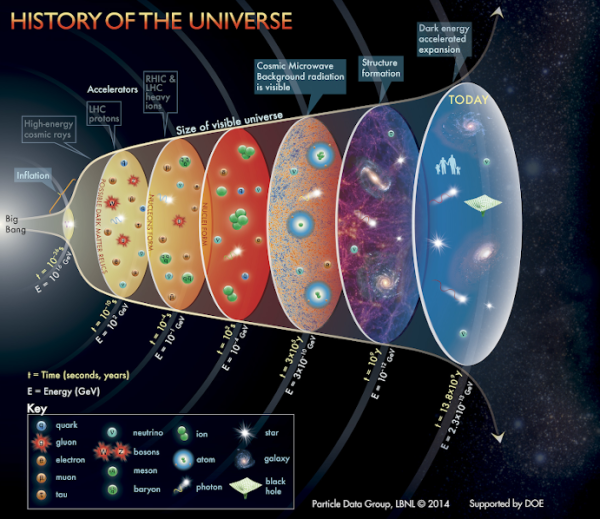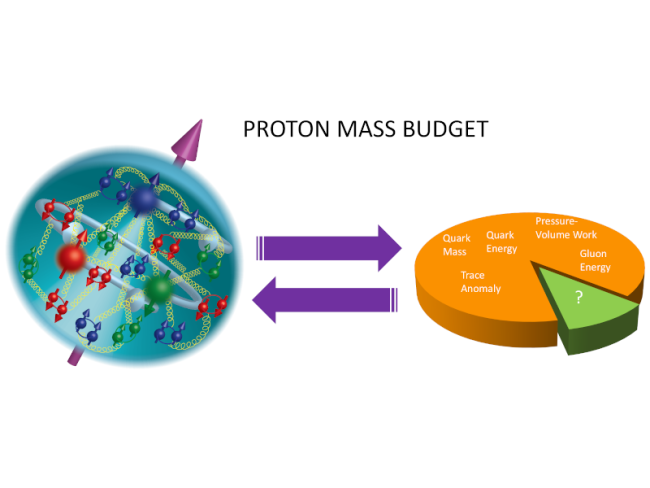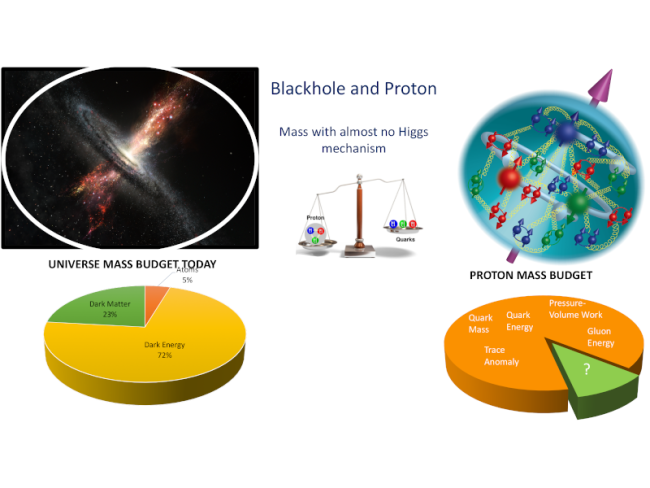Origin of the Visible Universe: Unraveling the Proton Mass

Note to applicants: This is a "hybrid" workshop, meaning there will be a combination of virtual and in-person participants. In the COMMENTS section of the Application Form, please write [In-person], [Virtual], or [Either] to reflect your preferred mode of attendance. Please be aware that all In-person participants must show proof of vaccination against COVID-19 upon arrival to the INT.
Disclaimer: Please be aware that due to ongoing concerns regarding the COVID-19 pandemic, this workshop may be changed from a hybrid workshop to online only.
This workshop will address the question: How does the mass of the nucleon arise? Which is listed first among three high-priority science questions identified by the National Academies of Sciences, Engineering, and Medicine (NAS) report titled An Assessment of U.S.-Based Electron-Ion Collider Science. To effectively address and understand the origin of the nucleon mass at an EIC, significant theoretical and experimental work remains. This workshop will continue to develop the science case around this high-priority science question, and help identify the concrete steps that need to be taken so that the EIC answers what is one of the most fundamental questions in modern science.
The importance of this question for nuclear physics is made clear when contrasted with the decomposition of the proton spin in terms of the spin and motion of its basic constituents, the quarks and gluons. For almost three decades this study has generated many groundbreaking experimental programs, which coupled with progress in theory has led to a paradigm shift in the way hadron structure is understood. For example, from these studies emerged the importance of the Wigner distributions of the quarks and gluons, which encapsulate information on hadron structure in terms of the constituents in position and momentum space. In contrast, the decomposition of the proton mass in terms of its constituents and their dynamics has received little attention from the nuclear physics community. This is despite the fact that the emergence of hadron masses from almost massless quarks and massless gluons is one of the most fascinating phenomena in coherence physics, and a cornerstone emergent property of QCD which is intimately tied to color entanglement and confinement.
Calculations of the hadron mass spectrum using lattice QCD have been incredibly successful, however, an intuition of how the mass of each hadron emerges from its constituents is not immediately provided by such calculations. In addition, these calculations do not lend themselves to communicating to a general audience a deeper understanding of how the quarks and gluons contribute to mass. The origin of the mass of the visible universe is one of the most profound questions in nuclear physics, as such, the interest in this question should transcend the field. An important goal of this workshop will be to help convey, to an audience broader than just nuclear physics, that the question of the origin of the mass of everyday matter goes to the very heart of understanding the universe—from its beginnings to the present day.
This workshop builds upon three previous meetings on the proton mass, the first in 2016 at Temple University, the second in 2017 at the ECT*, and the third in 2020 at Argonne. Since this time a lot of progress has been made and it is therefore timely that a broader, wider impact workshop be held.
A workshop registration fee may apply.
KEY QUESTIONS AND GOALS
Key topics for the workshop include:
-
How can lattice QCD help explore the role of the individual constituents—quarks and gluons—in making up hadron masses? For example, how do the strange and heavy quarks contribute to the proton mass?
-
What can a mass decomposition in terms of constituents, or a mass sum rule, teach us? We already know that mass decompositions are not unique, but can we take advantage of the non-uniqueness of the decomposition to cast it in terms of intuitive physical and measurable quantities?
-
How well can we control the approximations in analytical or model approaches? For example, how can we explore the proton wave function with controllable approximations, how can we quantify or improve the approximations, and what would indicate the success of the model calculations?
-
How do the phenomenological approaches compare with lattice QCD? For example, how do we interpret the current approximate 3σ discrepancy between state-of-the-art phenomenological extractions of the Nπ σ-term, using recent experimental constraints from pionic atom data, with lattice QCD determinations of this quantity?
-
Identify new measurements that could be pursued at a forthcoming EIC or at existing facilities, which could measure relevant observables directly linked to components of a given mass-decomposition. Examples are the measurements of the J/ψ electro- and photo-production at threshold at Jefferson Lab and an EIC, the spatial distribution of parton momenta and mass through moments of matrix elements of the energy-momentum tensor accessible through hard exclusive processes, and the measurement of Υ electro- and photo-production at threshold at an EIC.
-
What are the connections between the origin of the mass of the visible universe, the coupling of gravity to this matter, the dependence of its properties with variation of the quark masses, etc, and broader questions in cosmology?
We anticipate this workshop will lead to a summary article.
Note: A workshop registration fee may apply.


